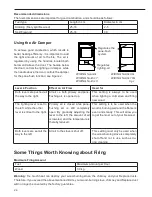
26
Be Careful of the Lacquer
The lacquer used to treat the wood-burning stove will harden the first 2-3 times the stove is fired, and
this can create unpleasant smoke and odours. Ensure therefore that the room is well ventilated. The door
must also be carefully opened; otherwise there is a risk that the seals will stick to the lacquer.
Warning:
The enclosed gloves can scratch the surface paint if the lacquer has not hardened properly. Be
careful not to touch the lacquered surfaces until after the first 2-3 firings.
Lighting
1.
Both the primary and secondary dampers are pushed as far to the right as possible. This
completely opens up both primary and secondary air.
2.
Stack 8-10 finely split pieces of firewood, corresponding to 1-2 kg, inside the wood-burning
stove. The smaller the sticks, the shorter the time needed for the stove to be heated and for the
optimal combustion temperature to be achieved.
3.
Place two firelighters between the top layer of kindling. WIKING recommends using high-quality
firelighters, as they do not produce smoke or odours.
4.
Light the firelighters. Keep the door ajar for a couple of minutes until the glass is hot - this pre
-
vents condensation. Then close the door completely.
5.
When the firewood is burning well, push the primary damper all the way to the left while slightly
adjusting the secondary damper to get an even and steady combustion.
Warning:
The door may only be kept open when lighting, adding firewood or cleaning the wood-burning
stove; otherwise combustion becomes too powerful, which in turn increases the risk of the stove be-
coming overheated.
Firing (adding firewood)
When there are no more visible flames and only a solid layer of embers remains, more fuel can be added
to the fire.
1.
Carefully open the door to prevent smoke and embers from escaping.
2.
Lay 2-4 pieces of split firewood (approximately 2 kg) on top of the embers.
3.
Close the door and completely open the primary and secondary dampers by pushing them to
the right.
4.
After a short while the flames should flare up again. When the firewood is fully ignited, push the
primary damper to the left again while slightly adjusting the secondary damper, until the flames
burn evenly and steadily.
Warning:
During combustion, the stove’s surfaces and door become extremely hot - exercise great
caution.
Some Things Worth Knowing about the Smoke Pipe
Description of the Smoke Pipe’s Function
The smoke pipe is the duct located between your wood-burning stove and chimney. All WIKING wood-
burning stoves are equipped with an exhaust pipe 150 mm in diameter.
If your stove is to be connected to a brick chimney, it is best to mount a curved smoke pipe to the stove’s
top outlet. Opting for this solution - in which the smoke pipe extends a half meter over the stove before















































